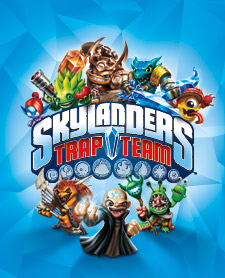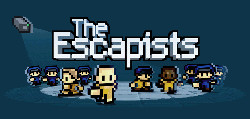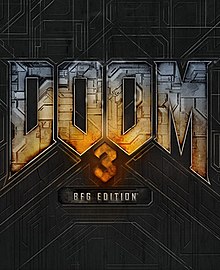
Doom 3 is a 2004 survival horror first-person shooter video game developed by id Software and published by Activision. Doom 3 was originally released for Microsoft Windows on August 3, 2004, adapted for Linux later that year, and ported by Aspyr Media for Mac OS X in 2005. Developer Vicarious Visions ported the game to the Xbox, releasing it worldwide on April 4, 2005.

Doom II, also known as Doom II: Hell on Earth, is a first-person shooter game by id Software. It was released for MS-DOS in 1994 and Macintosh in 1995. Unlike the original Doom, which was initially only available through shareware and mail order, Doom II was sold in stores.

Doom 64 is a first-person shooter game by Midway. It was first released for the Nintendo 64 in 1997, as the second spin-off game in the Doom series after Final Doom (1996), and the fourth game in the series overall. A remastered port was developed by Nightdive Studios and published by Bethesda Softworks for Nintendo Switch, PlayStation 4, Windows, and Xbox One in March 2020, and for Stadia in May 2020.

Castle Crashers is a 2D side-scrolling hack-and-slash video game developed by The Behemoth. The Xbox 360 version was released on August 27, 2008, via Xbox Live Arcade as part of the Xbox Live Summer of Arcade. The PlayStation 3 version was released in North America on August 31, 2010, and November 3, 2010, in Europe via the PlayStation Network. A Microsoft Windows version, exclusive to Steam, was released on September 26, 2012. The game is set in a fictional medieval universe in which a dark wizard steals a mystical crystal and captures four princesses. Four knights are charged by the king to rescue the princesses, recover the crystal, and bring the wizard to justice. The game includes music created by members of Newgrounds.

Madden NFL 08 is a 2007 American football video game based on the National Football League that was published by EA Sports and developed by EA Tiburon. It is the 19th installment in the Madden NFL video game franchise. It features Tennessee Titans quarterback Vince Young on the cover; San Diego Chargers defensive end Luis Castillo was the cover athlete for the Spanish-language version. This was the first Madden game made for 11 different platforms, it was released on August 14, 2007, for Xbox 360, Wii, PlayStation 3, PlayStation 2, Nintendo DS, PlayStation Portable, Xbox, GameCube and Microsoft Windows. There was also a version for Mac released on September 1, 2007. This was the last version of Madden to be released for Microsoft Windows until Madden NFL 19, and the last video game for the GameCube produced and released in North America.

Call of Duty 4: Modern Warfare is a 2007 first-person shooter video game developed by Infinity Ward and published by Activision. It is the fourth main installment in the Call of Duty series. The game breaks away from the World War II setting of previous entries and is instead set in modern times. Developed over two years, Modern Warfare was released in November 2007 for the PlayStation 3, Xbox 360, and Microsoft Windows and was ported to the Wii as Call of Duty: Modern Warfare – Reflex Edition in 2009.

Red Faction: Guerrilla is a third-person shooter video game developed by Volition and published by THQ. It was released for the PlayStation 3 and Xbox 360 in June 2009 and for Windows in September 2009. The game is the third installment in the Red Faction series. A remastered version titled Red Faction: Guerrilla Re-Mars-tered with improved graphics was released worldwide on July 3, 2018, for the PlayStation 4, Windows and Xbox One, and on July 2, 2019, for the Nintendo Switch.

Madden NFL 09 is an American football video game based on the NFL that was published by EA Sports and developed by EA Tiburon. It is the 20th annual installment in the Madden NFL video game franchise. The game was released for the Nintendo DS, PlayStation 2, PlayStation 3, PlayStation Portable, Wii, Xbox, Xbox 360, and mobile phones. It was the last video game for the original Xbox produced and released in North America and the last Madden game to be released for the Nintendo DS.

Doom is an American media franchise created by John Carmack, John Romero, Adrian Carmack, Kevin Cloud, and Tom Hall. The series usually focuses on the exploits of an unnamed space marine operating under the auspices of the Union Aerospace Corporation (UAC), who fights hordes of demons and the undead to save Earth from an apocalyptic invasion.

Darksiders II is an action role-playing hack and slash video game developed by Vigil Games and published by THQ. It is the sequel to Darksiders and was released in August 2012 for Microsoft Windows, PlayStation 3, Xbox 360 and as a launch title for Wii U upon the console's North American and PAL regions release in November of the same year. The story follows the efforts of player character Death to clear the name of his brother, War, who stands accused of wiping out humanity. On a total budget of $50 million, it was one of the most expensive video games to develop of all time.

Gal Gun, stylized as Gal★Gun, is a Japanese bishōjo rail shooter game developed by Inti Creates and published by Alchemist. It was first released on Xbox 360 in 2011, followed by a PlayStation 3 port a year later. The game takes place in a fictional academy in Japan, where the player takes the role of a male student, Tenzou Motesugi. He must shoot his female classmates, who are running desperately after him, with "Pheromone Arrows" to prevent them from making their partner, while he finds one of the four lead girls before sunset.

Metal Gear Solid HD Collection is a compilation of remastered ports of Metal Gear video games released for PlayStation 3 and Xbox 360 in 2011 and PlayStation Vita in 2012. The compilation contains Metal Gear Solid 2: Sons of Liberty and Metal Gear Solid 3: Snake Eater on all three platforms, plus Metal Gear Solid: Peace Walker on the home console versions, with the individual games all branded as HD Edition. Bluepoint Games handled the conversions of Metal Gear Solid 2 and 3, while Genki worked on Peace Walker.

Skylanders is a toys-to-life action-adventure video game franchise published by Activision. Skylanders games are played by placing a character's figure on the "Portal of Power", a device that reads its tag using NFC and "imports" them into the game as a playable character.

Painkiller: Hell & Damnation is a first-person shooter video game, both a remake of and a sequel to Painkiller, developed by The Farm 51 and published by Nordic Games. The game was released on October 31, 2012, for Microsoft Windows and for PlayStation 3 and Xbox 360 on June 28, 2013, in Europe after suffering multiple delays. It was released in North America for Xbox 360 through Xbox Live on October 1, 2013, and for PlayStation 3 through the PlayStation Store on November 26, 2013.
Just Dance is a rhythm game series developed and published by Ubisoft. The original Just Dance game was released on the Wii in 2009 in North America, Europe, and Australia.

Skylanders: Trap Team is a 2014 3D platform game developed by Toys for Bob and Beenox and published by Activision. It is the fourth installment in the Skylanders video game franchise and was released on October 2, 2014, in Australasia, October 5, 2014 in North America, and October 10, 2014, in Europe, for release on Android and iOS mobile platforms, PlayStation 3, PlayStation 4, Wii, Wii U, Xbox 360, Xbox One, and Nintendo 3DS. It is the sequel to Skylanders: Swap Force, and features the voices of Fred Tatasciore, Billy West, John DiMaggio, Matthew Moy, Laura Bailey, Alex Ness, John Paul Karliak, Matthew Yang King, and Richard Horvitz.

The Escapists is a strategy game played from a top-down perspective. The game was developed by Mouldy Toof Studios and following a Steam Early Access release in 2014, was released in 2015 for Microsoft Windows, macOS, Linux, Xbox 360, Xbox One and PlayStation 4. It was released on iOS and Android in 2017. A Nintendo Switch version of the game containing all downloadable content was released in 2018. The game was launched on the Epic Games Store on 23 September 2021, with the weekly free game campaign of Epic Games. Players assume the role of an inmate and must escape from prisons of increasing difficulty.
Super Mega Baseball is a baseball video game series developed by the independent studio Metalhead Software in Victoria, BC, Canada and published by EA Sports.
Dark Souls is a dark fantasy action role-playing game series developed by FromSoftware and published by Bandai Namco Entertainment. It began with the release of Dark Souls (2011) and has seen two sequels, Dark Souls II (2014) and Dark Souls III (2016). The series was created by Hidetaka Miyazaki and has received critical acclaim, with its high level of difficulty being among its most discussed aspects, while the first Dark Souls is often cited as one of the greatest games of all time. By 2023, the series had shipped over 35 million copies outside of Japan. Other FromSoftware games, including Demon's Souls, Bloodborne, and Elden Ring, share several related concepts and led to the creation of the Soulslike subgenre.

















